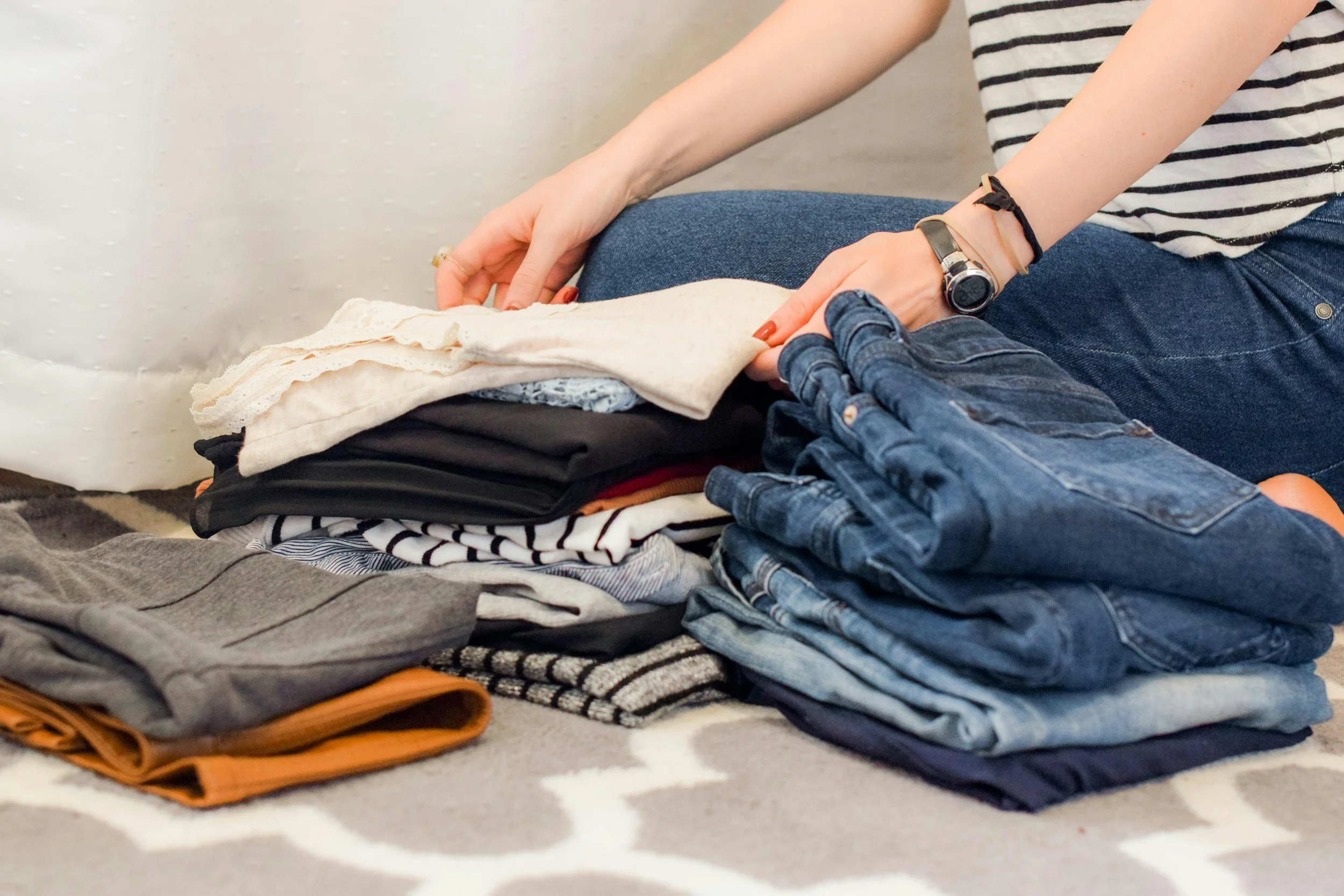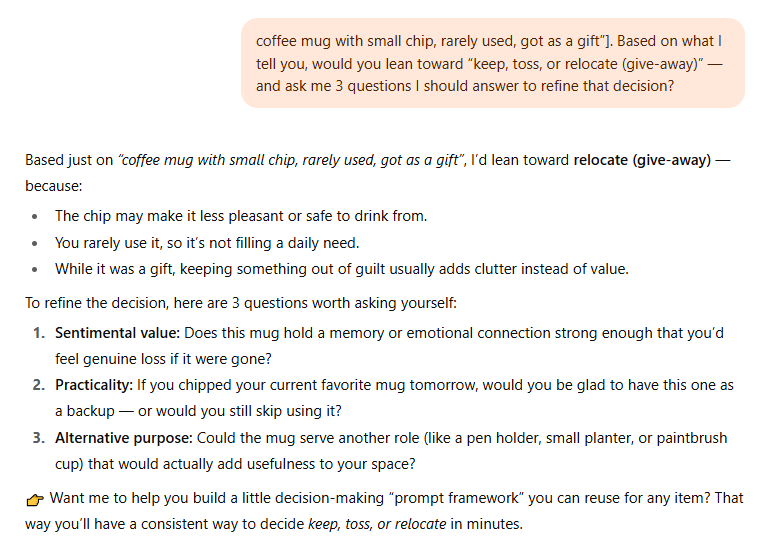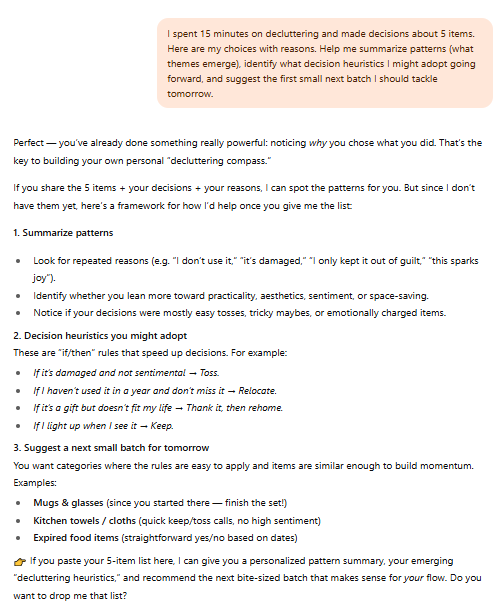Can AI Help Me Decide What to Keep or Toss?
Introduction
A few months ago, I found myself standing in front of my bookshelf (yes, that shelf) with a stack of books I’d never read, wearing socks with holes, and several mugs I never used. My internal monologue went: “Do I really need all this? But what if I regret tossing something?”
That’s when I thought: okay, what if I asked ChatGPT (or another AI) for help? Could it act like a patient friend who asks me good questions? Could it nudge me when I’m stuck in indecision?
In my experiments, the answer was: Yes — but only if you prompt it well, set guardrails, and treat it as a support tool, not a replacement for your feelings and memories.
Let me take you through how AI can help, where it falls short, and (most importantly) how you can use it yourself right now to make decisions easier and gentler.
Can AI Really Help Me Decide What to Keep or Toss?
How AI “thinks” about objects
AI like ChatGPT is trained on massive text corpora. It doesn’t see your stuff physically; it understands based on descriptions, rules, heuristics, and models of human preferences. When you ask it “Should I keep this?” it leans on patterns: sentiment, utility, frequency of use, emotional weight, and clutter theory.
For example: in a recent article from Homes & Gardens, someone used the AI’s “keep / toss / relocate” method and a 20-minute timer to break decision fatigue and create momentum. Homes and Gardens
Also, Forbes recently published a piece on how generative AI is being used by people to “declutter your life” — not just objects, but schedules, digital clutter, relationships, and choices. Forbes
So yes, AI has some useful heuristics. But the key is: your human judgment still matters. AI can structure, question, suggest — but the decision is yours.
What AI can do well
Ask clarifying questions: When you describe an object, AI can respond with probing questions (“When did you last use it? Does it spark joy or anxiety?”).
Suggest decision rules: It can propose rational heuristics (e.g. “if not used in 12 months, consider letting go”) or craft personalized rules based on your lifestyle.
Generate prioritization systems: “Of these ten mugs, keep top three you love or use daily, donate the rest.”
Offer emotional reframing: “It’s okay to let go of things even if they have memory — the memory stays, the physical object doesn’t define it.”
Structure a declutter workflow: Step-by-step actions, checklists, schedules, micro-tasks you can do in 10 or 20 minutes.
What AI can’t (or shouldn’t) do
Feel your sentimental attachments: AI can’t “know” the nostalgic weight you attach to that sweater your grandmother gave.
Override your values: If minimalism isn’t your style, AI can’t force you to adopt it authentically.
Be perfect in context: It might misjudge usefulness if your lifestyle is niche (e.g. hobby tools, rare plants).
Replace the messy emotional work: Letting go is often emotional. Sometimes you need to pause, sit with resistance.
In short: AI is a facilitator, not a judge.
The AI-Backed “Keep or Toss” Workflow (with Prompts You Can Use)
Here’s a workflow I tested on my own clutter — your mileage will vary, but it gives structure so decisions don’t feel random.
Step 0: Set context and caveats in your prompt
Before you even show item descriptions to AI, prime it:
"Pretend you’re my decluttering coach. I sometimes struggle emotionally with parting. I want thoughtful prompts, gentle suggestions, not harsh judgments. Use human tone."
This tells the AI how to frame answers.
Step 1: Ask it to rate items with follow-up questions
Prompt A:
“Here’s an item: [describe item: “coffee mug with small chip, rarely used, got as a gift”]. Based on what I tell you, would you lean toward “keep, toss, or relocate (give-away)” — and ask me 3 questions I should answer to refine that decision?”
You’ll often get a first lean + questions like “When did you last use it?” or “Does it match your style or mood?”
You answer, then resend to it:
Prompt B (iteration):
“Based on my answers (I last used it 18 months ago; I like it aesthetically but rarely use it), what’s your suggestion and why? Also, what’s a low-stakes way I could test whether to let it go or not?”
At this point, AI might suggest keeping it temporarily or donating as trial.
Step 2: Batch-process items
For example, with 20 mugs:
Prompt C:
“Here are 10 descriptions of mugs in my collection (list name, condition, usage frequency, sentimental value). Please rank them from “strong keep” to “strong toss,” and pick the top 2 I might consider letting go — giving me reasoning and some doubting questions for those 2.”
This helps you see patterns — sometimes seeing them from a distance is clarifying.
Step 3: Use “hesitation flags” for difficult items
Prompt D:
“I have a hesitation about [this sentimental object]. Help me do a “test keep” — a 30-day holding period plan so I can decide later. What should I do with it, how often revisit, what questions to ask weekly?”
This prevents immediate regret and allows emotional space.
Step 4: Summarize daily micro-decisions
Prompt E:
“I spent 15 minutes on decluttering and made decisions about 5 items. Here are my choices with reasons. Help me summarize patterns (what themes emerge), identify what decision heuristics I might adopt going forward, and suggest the first small next batch I should tackle tomorrow.”
“What if I give vague or messy descriptions?” — Tips for Better Results
Be as concrete as possible: material, size, condition, when last used, how it makes you feel.
Give constraints or context: e.g. “I only keep 3 mugs for daily use,” or “I’m trying to reduce kitchen clutter.”
If unsure, send photos with captions (in GPT-4 image mode or tools that accept images) and ask for suggestions.
Use time limits (e.g. 10-minute “decision rounds”) to avoid overthinking.
If you want more help with setting up routines, systems, or organizing in a bigger way, check out my post AI Home Organization: How ChatGPT Can Help You Declutter and Simplify Your Space. It dives deeper into room-by-room planning, sustaining habits, and AI for ongoing maintenance.
FAQ (with examples)
Q1: Is AI reliable enough to trust “keep/toss” decisions?
A: It depends on how you use it. AI’s suggestions are only as strong as its input. If you describe something vaguely (“old mug”), it may misjudge. But if you give rich context (usage, emotional weight, practicality), it can give surprisingly good guidance. Use it as counsel, not a dictator.
Example: I once gave AI a description of a sweater: “worn once in two years but it’s cozy.” It suggested relocate (donate trial) rather than toss immediately. That nudged me to box it and revisit—later, I realized I indeed never wore it again and donated it with less guilt.
Q2: What about digital clutter—photos, files, apps?
A: Same logic applies. Describe your digital space to AI: “I have 50 duplicate photos in phone album, many blurry screenshots, apps I never open.” Ask it to categorize “keep / archive / delete” and to walk you through decision questions: “When did I last open this file? Is it tied to a project? Do I need a searchable version only?” Many people use AI to sift emails, decide which apps to remove, or curate photo libraries. (You can even combine it with duplicate-finder tools.)
Example: A blogger used ChatGPT to audit her 3000 old email drafts—AI grouped them by topic, flagged ones never opened, and she purged 40% with confidence.
Q3: Won’t it feel robotic to let AI help with emotionally meaningful items?
A: It might—but that’s okay. It doesn’t replace your feelings; it just helps structure your thinking. Use “hesitation flags” (test keeps) as bridges. Also, ask the AI to phrase decisions gently. For example:
“I understand this has sentimental value. Even if I let it go, here are ways I can preserve memory without keeping the object…”
You can ask it to write a short note or story about the object, so even if you part, you don’t lose memory.
Q4: What if I “mess up” and later want an item back?
A: That’s part of the process. Many organizers suggest creating a “reclaim box” (e.g. 30-day box): items that you removed go into it, and only after 30 days you decide permanently. AI can help you create that schedule, remind you, or suggest a re-evaluation prompt (e.g. “Have I thought about this item in 30 days? If not, likely it’s safe to let go.”).
Q5: Can I use this with children’s things, gifts, heirlooms?
A: Yes — but judgments may be more nuanced. Ask the AI to add extra sensitivity:
“When giving suggestions, factor in sentimental value, children’s attachment, family dynamics, and non-monetary meaning.”
You can also ask for group strategies (e.g. decide as a family together, set limits like “we keep 10 toys per child,” etc.). The AI can help you structure that conversation too.
Final Thoughts (You’re Not Alone in This)
Deciding what to keep or toss is messy. It’s emotional, sometimes agonizing, often slow. But you don’t have to do it in isolation. AI can be a kind companion—not a judge.
When I used these methods, I found that having a structured questioner (AI) by my side made the process less random, less guilt-laden, more thoughtful. I decluttered a chunk of my closet in one evening, but more importantly, I felt lighter—not because I lost things, but because I regained clarity.
So grab a few items, open ChatGPT or another AI tool, and try prompt A or B above. Let it ask you questions. Let it help you see patterns. Use your human heart to decide.
You’ve got this.


